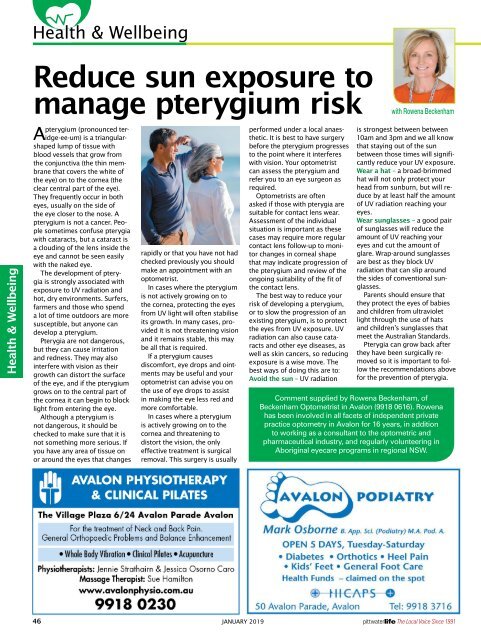Pittwater Life January 2019 Issue
Locals' Guide - 143 Things You Can Do (at the very least). So Are You Ready To Rock? 'Lifegift' Free Trial.
Locals' Guide - 143 Things You Can Do (at the very least). So Are You Ready To Rock? 'Lifegift' Free Trial.
Create successful ePaper yourself
Turn your PDF publications into a flip-book with our unique Google optimized e-Paper software.
Health & Wellbeing<br />
Health & Wellbeing<br />
Reduce sun exposure to<br />
manage pterygium risk<br />
pterygium (pronounced teridge-ee-um)<br />
is a triangular-<br />
A<br />
shaped lump of tissue with<br />
blood vessels that grow from<br />
the conjunctiva (the thin membrane<br />
that covers the white of<br />
the eye) on to the cornea (the<br />
clear central part of the eye).<br />
They frequently occur in both<br />
eyes, usually on the side of<br />
the eye closer to the nose. A<br />
pterygium is not a cancer. People<br />
sometimes confuse pterygia<br />
with cataracts, but a cataract is<br />
a clouding of the lens inside the<br />
eye and cannot be seen easily<br />
with the naked eye.<br />
The development of pterygia<br />
is strongly associated with<br />
exposure to UV radiation and<br />
hot, dry environments. Surfers,<br />
farmers and those who spend<br />
a lot of time outdoors are more<br />
susceptible, but anyone can<br />
develop a pterygium.<br />
Pterygia are not dangerous,<br />
but they can cause irritation<br />
and redness. They may also<br />
interfere with vision as their<br />
growth can distort the surface<br />
of the eye, and if the pterygium<br />
grows on to the central part of<br />
the cornea it can begin to block<br />
light from entering the eye.<br />
Although a pterygium is<br />
not dangerous, it should be<br />
checked to make sure that it is<br />
not something more serious. If<br />
you have any area of tissue on<br />
or around the eyes that changes<br />
rapidly or that you have not had<br />
checked previously you should<br />
make an appointment with an<br />
optometrist.<br />
In cases where the pterygium<br />
is not actively growing on to<br />
the cornea, protecting the eyes<br />
from UV light will often stabilise<br />
its growth. In many cases, provided<br />
it is not threatening vision<br />
and it remains stable, this may<br />
be all that is required.<br />
If a pterygium causes<br />
discomfort, eye drops and ointments<br />
may be useful and your<br />
optometrist can advise you on<br />
the use of eye drops to assist<br />
in making the eye less red and<br />
more comfortable.<br />
In cases where a pterygium<br />
is actively growing on to the<br />
cornea and threatening to<br />
distort the vision, the only<br />
effective treatment is surgical<br />
removal. This surgery is usually<br />
performed under a local anaesthetic.<br />
It is best to have surgery<br />
before the pterygium progresses<br />
to the point where it interferes<br />
with vision. Your optometrist<br />
can assess the pterygium and<br />
refer you to an eye surgeon as<br />
required.<br />
Optometrists are often<br />
asked if those with pterygia are<br />
suitable for contact lens wear.<br />
Assessment of the individual<br />
situation is important as these<br />
cases may require more regular<br />
contact lens follow-up to monitor<br />
changes in corneal shape<br />
that may indicate progression of<br />
the pterygium and review of the<br />
ongoing suitability of the fit of<br />
the contact lens.<br />
The best way to reduce your<br />
risk of developing a pterygium,<br />
or to slow the progression of an<br />
existing pterygium, is to protect<br />
the eyes from UV exposure. UV<br />
radiation can also cause cataracts<br />
and other eye diseases, as<br />
well as skin cancers, so reducing<br />
exposure is a wise move. The<br />
best ways of doing this are to:<br />
Avoid the sun – UV radiation<br />
with Rowena Beckenham<br />
is strongest between between<br />
10am and 3pm and we all know<br />
that staying out of the sun<br />
between those times will significantly<br />
reduce your UV exposure.<br />
Wear a hat – a broad-brimmed<br />
hat will not only protect your<br />
head from sunburn, but will reduce<br />
by at least half the amount<br />
of UV radiation reaching your<br />
eyes.<br />
Wear sunglasses – a good pair<br />
of sunglasses will reduce the<br />
amount of UV reaching your<br />
eyes and cut the amount of<br />
glare. Wrap-around sunglasses<br />
are best as they block UV<br />
radiation that can slip around<br />
the sides of conventional sunglasses.<br />
Parents should ensure that<br />
they protect the eyes of babies<br />
and children from ultraviolet<br />
light through the use of hats<br />
and children’s sunglasses that<br />
meet the Australian Standards.<br />
Pterygia can grow back after<br />
they have been surgically removed<br />
so it is important to follow<br />
the recommendations above<br />
for the prevention of pterygia.<br />
Comment supplied by Rowena Beckenham, of<br />
Beckenham Optometrist in Avalon (9918 0616). Rowena<br />
has been involved in all facets of independent private<br />
practice optometry in Avalon for 16 years, in addition<br />
to working as a consultant to the optometric and<br />
pharmaceutical industry, and regularly volunteering in<br />
Aboriginal eyecare programs in regional NSW.<br />
46 JANUARY <strong>2019</strong><br />
The Local Voice Since 1991

















